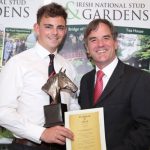Lillingston Bringing Heart to the Game
by Chris McGrath, originally published on thoroughbreddailynews.com
In some respects, all splendid, he is a genuine throwback. You could dress Luke Lillingston in a hussar’s uniform, put him in a time machine, and walk him straight into Wellington’s tent at Waterloo. Within five minutes–so immaculate are his manners, so trustworthy is his bearing–he would be walking out, jaw set, carrying a map and a set of orders.
But just as his residence at Mount Coote is actually far more modern than is superficially apparent, so Lillingston is fully engaged in the challenges of breeding and racing Thoroughbreds in the 21st Century. Though the house was rebuilt in the early 1960s, the reconstruction was faithful to the glorious strictures of Georgian architecture. In much the same way, Lillingston feels a due obligation to the sustainability not only of the family stud–which has reared or raised the winners of 167 stakes races since 1963 –but also that of the sport as a whole. So it was that this ardent traditionalist was last year able to dismantle the barriers around one of the Turf’s most privileged enclaves: the winner’s enclosure at Royal Ascot. No fewer than 51 members of his Hot To Trot syndicate had somehow been secured paddock passes; 10 as the official quota, the rest begged and borrowed from Lillingston’s many friends in the game.
After Heartache (GB) (Kyllachy {GB}) won the G2 Queen Mary S., Lillingston remembers himself “completely away with the fairies, leading this mad happy herd of people” past the course’s director of racing and communications, Nick Smith, to greet their filly. “Absolutely marvellous!” Lillingston exclaimed, seeing Smith. “We got them all in!” “So I see,” replied Smith–as stonily as anyone could permit himself to be, confronted with this most irrepressible, most irresistible of enthusiasts. Heartache’s success represented a spectacular vindication of Lillingston’s determination (along with syndicate manager Sam Hoskins) to show that anyone, in the sport of kings, can be king for a day.
“One of the things that is important to me is trying to get more people involved,” he explains. “Hot To Trot very much started by thinking about all those people out there, who love their racing, and how we could give them the chance actually to race horses themselves. Because the idea is not only that you’re entertaining people but that you’re educating them as well. And from that, you hope, there might be a natural osmosis. “Think of Trevor and Libby Harris, who own Lordship Stud. It’s a lovely farm, they’ve had quite a lot of success, and I’ve been happy to help them for more than 20 years now. But they came in via one of Henry Ponsonby’s syndicates. They’re from an entirely non-horse background, but happened to go racing one evening at Newmarket and saw some delirious owners leading their horse into the winner’s enclosure. And they said: ‘I’d like a bit of that.’ That’s what it’s all about. Whether it’s Elite Racing or Kennet Valley or Highclere, there’s a chance for everybody to get involved in this game at some level.” In the case of Hot To Trot, now extended to a second syndicate, costs are kept manageable (at ,2,095 for six horses) by leasing stock from breeders. So while shareholders have no equity in the horseflesh itself, they do get to divide prizemoney.
Proceeding from Ascot, Heartache was beaten just half a length when third in the G2 Prix Robert Papin. The winner, Unfortunately (Ire) (Society Rock {Ire}), then followed up by beating Havana Grey (GB) (Havana Gold {Ire}) in the G1 Morny. And the runner-up then filled the same position behind Heartache in what looked a very strong edition of the G2 Flying Childers S., the pair clear. So there would seem to be every prospect of Heartache cutting it at Group 1 level this term. Out of a Compton Place (GB) (Indian Ridge {Ire}) mare, she is a typical speed-on-speed Whitsbury Manor graduate and Clive Cox has an obvious initial goal in the G1 Commonwealth Cup back at Royal Ascot, taking in the Sandy Lane S. at Haydock en route. “She looks terrific, and she’s grown,” Lillingston reports. “She’s not just a one-season horse, we think; certainly to look at.” For all this grass-roots evangelism, of course, Lillingston’s first priority is to extend the rather deeper foundations at Mount Coote. Originally the family seat of a Cromwellian officer named Coote, the estate outside Kilmallock in Co Limerick was bought in 1938 by Lillingston’s grandfather, a Leicestershire hunting man, who had stayed there once as a guest of the first Lord Daresbury.
He did not bother to revisit the site before sealing the deal, being perfectly satisfied by what he could remember of “the view from my bedroom window.” Little wonder, when he could gaze across all that velvet pasture and woodland between the Ballyhoura Hills and the River Maigue, on the banks of which cluster a series of exceptionally fertile stud farms, relative to their size. Tragically he was killed soon afterwards, during the Normandy push in 1944, when his son Alan–Lillingston’s father–was just nine. Alan, of course, became one of the most respected horsemen of his generation. He was a champion amateur, notably winning the 1963 Champion Hurdle on the one-eyed Winning Fair, and then proceeded to master a second discipline to win European gold as a three-day eventer. But his most enduring legacy was to give fresh life to the old cobbled stable yard that had previously (bar some minor dabbling in Thoroughbreds by his mother) only housed hunters. “He was helped by his uncle, Geoffrey Brooke at Clarehaven in Newmarket, a special man,” Lillingston explains. “But my father essentially started out with a couple of mares and no money. And then he got a lucky break, when Jocelyn Hambro gave him half of a mare named Trial By Fire. Her son Deep Run became champion 2-year-old of 1968, and the first great stallion John Magnier ever stood.” By which stage Mount Coote was up and running, having already produced another smart juvenile in 1964 Richmond S. and July S. winner Ragtime.
Over the following years Mount Coote established a footprint in many key modern pedigrees, not least thanks after its selection by the Whitney family to board its mares in Europe. Mount Coote also bred and sold a filly by Realm, for 6,200gns at Tattersalls in 1976; as Hatta, she became Sheikh Mohammed’s first winner. The partnership with Hambro, meanwhile, came up with a first Classic winner for Mount Coote in One In A Million (1979 1000 Guineas), subsequently a foundation mare for Egon Weinfeld at Meon Valley. And Tudor Melody stood here before his sale to the National Stud in England, which paid off all debts on the reconstruction of the mansion. “My father took his first horse to Tattersalls in 1958,” says Lillingston. “We had a party for him at the Jockey Club Rooms in 2008, after he had sold horses at Tattersalls for 50 consecutive years, which I think is a fair old achievement. If you go back to the catalogues of the late 1950s, you’ll find very few names that were the same. He did a fantastic job, building it up. Luckily he started breeding horses when the market was really running away, which was undoubtedly lucrative.
“My father was also a fantastic teacher. He got me going on pedigrees when I was about seven or eight. He had shares in horses like Northfields and Home Guard, in some of the early Coolmore sires, and would have retained shares in Tudor Melody. So as a young lad I’d go through The Sporting Life every day and mark out all the horses by those stallions.” That process is being reprised now by Lillingston’s own children, Hugh and Lara, and nor is there any diminution in the quality of the horses in which they can feel involved. In the Prix Vermeille last autumn, for instance, a 14th Group 1 winner graduated from Mount Coote in Bateel (Ire) (Dubawi {Ire}), who was foaled here.
As Lillingston drives the 500 acres of limestone pasture, on his morning feed round, he exudes a gratified sense of his place in the long, patient cycles of husbandry. “Come along ladies!” he calls, as the feed rattles into buckets distributed on compounds of hard standing between the mares’ soggy paddocks. He is a great believer in keeping stock outdoors as much as possible, to absorb the benefits to bone and physiology of the land and climate. He is in his element and, long of shank and straight of back, has become every bit as cherished a figure in the game as was his late father. Again, however, it would be wrong to think of Lillingston merely in terms of continuity. His father made sure of that, sending him off to New York as an impressionable young man to learn how to stand on his own two feet; and to see the business through other eyes. Lillingston has duly adapted his legacy to wear many different hats. The Mount Coote brochure is titled “The Complete Package”, comprising boarding, breeding advice, bloodstock management, sales preparation and consigning. Then there is his association with Lincoln Collins in Lexington, with an ambitious young assistant in his stud office in Charlie Dee.
Day by day, then, you never know where a Mount Coote footprint will appear. Most famously, Lillingston and his team realised a European record of 4,700,000gns consigning Immortal Verse (Ire) (Pivotal {GB}) at the Tattersalls December Sale of 2013. But only the other day Nordic Lights (GB) (Intello {Ger}), bought as a foal by Kern/Lillingston, made it two out of two for Charlie Appleby at the Craven meeting. “The stud is our core business,” Lillingston acknowledges. “We breed 30-odd mares, many with partners: I like doing things with other people. We consign some horses for other people, too, but most of those will have been raised here. We’ve been lucky enough to sell horses for Mrs Tsui, for instance.@ “We take our matings very seriously: I think an awful lot about them. I like performance, in the mares we have; if they don’t have it, I like their dams to. But after that obviously understanding pedigrees is very important. I think commercially it’s very challenging. The top of the market was fantastically strong last year, but you’re talking about the top 20%, really, and I don’t think there was a great deal in the way of a trickledown effect.” There is no prospect, however, of extending his repertoire to revive the days of Native Prince, the last stallion his father stood here.
Instead Lillingston has built an astute portfolio of seasons, getting aboard on the ground floor with such upwardly mobile stallions as Dark Angel (Ire) (Acclamation {GB}), Siyouni (Fr) (Pivotal {GB}), Lope De Vega (Ire) (Shamardal), Showcasing (GB) (Oasis Dream {GB}, Havana Gold (Ire) (Teofilo {Ire}) and Cityscape (GB) (Selkirk). “The great thing with horses is that you’ve always got something to look forward to,” he enthuses. Really, those lucky people at Hot To Trot couldn’t ask for a more infectious envoy from the arcane world of the Turf. But Lillingston is candid in his concern that new investment in the industry, on a larger scale, is at the mercy of its own bad apples.
“I have met several people in the last year who won’t invest in racing, who won’t participate, because they feel that if they walk in there they’ll be eaten for breakfast,” he says. “And, in some cases, they would be. And that’s awful. There is a review going on, so we’ll see. But I think that if our integrity was better, there would be more confidence in the business. People coming in have to have a fair crack of the whip. Because there’s a shortage of them, there really is.” He hates to be provocative, but is just too decent a man to stand by and say nothing. “I do feel quite strongly about this,” he says. “Because it’s all part of the same thing [as Hot To Trot]: you want more people to come in and enjoy it. I make my living out of it, and feel bloody lucky to do so. The horse is a wonderful animal for people to get together. Have you seen that Guinness advertisement, where the down-and-out from the back streets is put together with a horse on the way to the slaughterhouse? And he says: ‘I don’t know if I saved the horse, or the horse saved me.’ What we have is very special and if people can come in and enjoy it, it can literally change their lives.”


